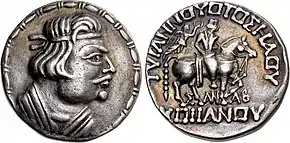| Heraios | |||||
|---|---|---|---|---|---|
 | |||||
| Kushan ruler | |||||
| Reign | c. 1 –30 CE | ||||
| Coronation | 1 BCE | ||||
| Predecessor | Sapadbizes | ||||
| Successor | Kujula Kadphises | ||||
| Born | 23 BCE Taskhand | ||||
| Died | 30 CE Srinagar ? | ||||
| Issue | Kujula Kadphises, Vima Takto | ||||
| |||||
| Dynasty | Kushan | ||||
| Kushan emperors 30 CE–350 CE | ||||||||||||||||||||||||||||||
|---|---|---|---|---|---|---|---|---|---|---|---|---|---|---|---|---|---|---|---|---|---|---|---|---|---|---|---|---|---|---|
|
||||||||||||||||||||||||||||||
Heraios (Bactrian: Ηλου Ēlou, sometimes Heraus, Heraos, Miaos) was apparently a king or clan chief of the Kushans (reign: c. 1 –30 CE), one of the five constituent tribes of the Yuezhi, in Bactria, in the early 1st century CE.[1]
Several scholars question his existence as a separate historical figure and suggest that "Heraios" may have been another name for his nominal successor Kujula Kadphises.[2] For example, numismatist Joe Cribb points out the similarity of coins minted by Kujula to those of a Greco-Bactrian predecessor named Hermaios Soter (or Hermaeus Soter). Moreover, some portraits of Kujula resemble Hermaios, suggesting that Kujula may have initially reused the design of coins issued during the reign of Hermaios Soter.[3]
The coins bearing the name Heraios were silver and made in the Hellenistic style, using the Greek script. The reverse shows the winged Greek goddess of victory Nike holding out a wreath, over Heraios mounted on a horse. He wears a tunic and has a large bow on the side. Some portraits show Heraios with a marked artificial skull deformation, a characteristic of several Kushan portraits and sculptures of the 1st century CE. On some of the Heraios coins, his name has sometimes been read as ΗΛΟΥ or ΗΙΛΟΥ, which has been transliterated as "Ilou". However other readings of the same texts include "Maou" and "Miaou".
 Another coin type of Heraois, c. 1- 30/50 CE
Another coin type of Heraois, c. 1- 30/50 CE The ethnonym "KOϷϷANO" (Koshshano, "Kushans") in Greek alphabet (with the addition of the letter Ϸ, "Sh") on a coin of Heraios.
The ethnonym "KOϷϷANO" (Koshshano, "Kushans") in Greek alphabet (with the addition of the letter Ϸ, "Sh") on a coin of Heraios. Tetradrachm, obverse: diademed Heraos right, 1st half of the 1st century CE. From Vakhsh, Tajikistan.
Tetradrachm, obverse: diademed Heraos right, 1st half of the 1st century CE. From Vakhsh, Tajikistan.
References
- ↑ Ancient Coin Collecting VI: Non-Classical Cultures p.92 Wayne G. Sayles F+W Media, Inc, 1999
- ↑ Rezakhani 2017, p. 54.
- ↑ Cribb, Joe (1993). The Heraus Coins: Their Attribution to the Kushan King Kujula Kadphises, c. AD 30-80 (PDF). London: Spink. pp. 116–140. Retrieved 2018-03-08.
{{cite book}}:|work=ignored (help)
Sources
- Rezakhani, Khodadad (2017). "East Iran in Late Antiquity". ReOrienting the Sasanians: East Iran in Late Antiquity. Edinburgh University Press. pp. 1–256. ISBN 9781474400305. JSTOR 10.3366/j.ctt1g04zr8. (registration required)
- Sinisi, Fabrizio (21 October 2022). "Again on "Heraios" Being Kujula and Some Related Problems". Electrum. 29: 87–107. doi:10.4467/20800909EL.22.007.15777.

